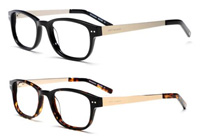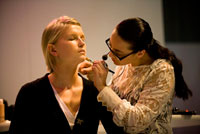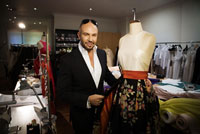Gabi Hollows The Fred Hollows Foundation and Specsavers Collaboration Interview
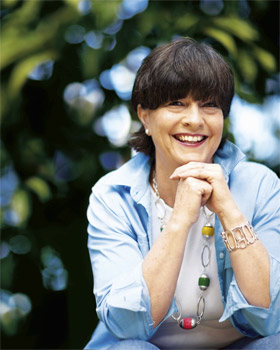
Gabi Hollows The Fred Hollows Foundation and Specsavers Collaboration Interview
Aboriginal and Torres Strait Islander adults are six times more likely than other Australians to go blind, even though their children have better vision than the mainstream population. 94% of vision loss for adults is preventable or treatable; but as more than a third of Indigenous adults have never had an eye exam, many disorders go undiagnosed and untreated. Vision loss among Aboriginal and Torres Strait Islander adults causes 11% of the health gap, yet most vision loss can be corrected overnight.
Specsavers is partnering with The Fred Hollows Foundation to raise much needed funds to help close the health gap for vision loss in Australia. Specsavers has been granted the use of Indigenous artist Langaliki Langeliki's beautiful artwork which has been added to bestselling -Toby' frames. Lanagliki has undergone two cataract eye surgeries, thanks to The Fred Hollows Foundation.
The frame will retail within the -two pairs for $199 range, with $25 from each frame sold going to The Fred Hollows Foundation. The limited edition frames will be available in store from 27th March; only 2,500 pairs will be made.
Interview with Gabi Hollows
Question: What inspired The Fred Hollows Foundation collaboration with Specsavers?
Gabi Hollows: Like The Fred Hollows Foundation, Specsavers are passionate about making high quality eye care accessible to everyone, so it was only natural that we would partner with someone that understands what we're trying to achieve.
We're thrilled to be involved in the Specsavers Community Program. The program raises funds for selected local charities around the country and The Fred Hollows Foundation, Specsavers national charity partner.
In a bid to raise awareness of the importance of eye health for Indigenous Australians in particular, Specsavers has collaborated with Aboriginal artist, Langaliki. She has undergone two cataract operations with the help of The Foundation and has given permission for one of her beautiful paintings to be transferred onto limited edition frames. $25 from the sale of each of these frames goes to The Foundation.
Question: What do you hope to achieve from this collaboration?
Gabi Hollows: Aboriginal and Torres Strait Islander adults are six times more likely than other Australians to go blind, even though their children have better vision than the mainstream population. We hope to raise additional funds to restore sight in Indigenous communities so we can ultimately bridge the gap on vision loss between Indigenous and non-Indigenous Australians.
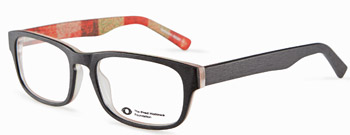 Question: In terms of awareness; what message do you hope to promote?
Question: In terms of awareness; what message do you hope to promote?
Gabi Hollows: Aboriginal and Torres Strait Islander people are more likely than other Australians to go blind. Yet 94% of vision loss among Indigenous adults is preventable or treatable. 1We can improve this situation through early detection with the appropriate resources. We hope to raise awareness of eye health and highlight the importance of having regular eye tests and leading a healthy lifestyle.
Question: What is needed to help close the health gap for vision loss in Australia?
Gabi Hollows: Vision loss among Aboriginal and Torres Strait Islander adults is responsible for 11 per cent of the health gap. Four conditions cause 94% of the vision loss among Indigenous adults: Refractive error, cataract, diabetic retinopathy and trachoma. But 35% of adults have never had their eyes examined. People need to know why eye health is so important, what can be done and to have access to top quality health services.
The Foundation is an active participant of the Close the Gap Campaign, through the National Steering committee, working to close the health and life expectancy gap between Aboriginal and Torres Strait Islander people and non-Indigenous Australians within a generation. The Foundation's specific role is to ensure that ending avoidable blindness is a key part of this agenda. That is why we work to raise awareness of the importance of eye health and continue to raise funds to treat avoidable blindness. For the first time, we have an eye health case study in the Close the Gap Progress and Priority Report.
Question: Langaliki Langeliki's has granted the use of her artwork for the fundraising; can you talk us through how The Fred Hollows Foundation aided her with her two cataract eye surgeries?
Gabi Hollows: The Fred Hollows Foundation provides optometry services in a number of remote communities. Langaliki was just one of the many patients to have been diagnosed and treated. Langaliki has undergone two cataract operations thanks to The Foundation which has allowed to her to continue to create her wonderful artwork.
Question: How does the eye health of Indigenous Australians differ?
Gabi Hollows: Aboriginal and Torres Strait Islander adults have less access to eye health services and are more likely to experience risk factors for poor eye health, such as Type 2 Diabetes and trachoma which only exists in remote Indigenous communities.
Question: How do you hope to encourage more Indigenous adults to have eye exams?
Gabi Hollows: We work closely with local Indigenous-controlled health agencies who provide services to their communities. Advocacy, education and empowerment are tools we provide to make this difference.
Question: Can you talk us through the aim of The Fred Hollows Foundation over the coming years?
Gabi Hollows: Fred's vision has always been to end avoidable blindness and improve Indigenous health. With the help of our local program partners, Australian public supporters and our corporate partners such as Specsavers, The Fred Hollows Foundation is now closer to making this a reality over the coming years.
We will end trachoma in Australia before 2020 and we will implement new technology in tele-health that enables high quality eye health data to be assessed in some of the most remote communities in Australia.
I was delighted to see the Indigenous artist, Langaliki have her beautiful artwork featured on a Specsavers limited edition frame which went on sale in March this year.
Interview by Brooke Hunter
Have You Seen This?

$800 Specsavers Voucher
Thanks to Specsavers here is your chance to win a Specsavers voucher valued at over $800.00.
MORE


